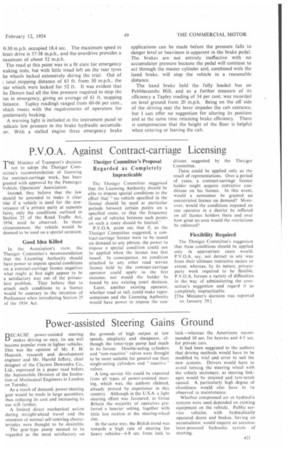Power-assisted Steering Gains Ground
Page 55

If you've noticed an error in this article please click here to report it so we can fix it.
BECAUSE power-assisted steering makes driving so easy, its use will become popular even in lighter vehicles. This was the opinion of Mr. F. H. Heacock, research and development engineer and Mr. Harold Jeffery, chief designer of the Clayton Dewandre Co., Ltd., expressed in a paper read before the Automobile Division of the institution of Mechanical Engineers in London on Tuesday.
As a result of demand, power-steering gear would be made in large quantities. thus reducing its cost and increasing its use still further.
A limited direct mechanical action during straight-ahead travel and the retention of normal self-centring characteristics were thought to be desirable.
The gear-type pump seemed to be regarded as the most satisfactory on the grounds of high output at low speeds, simplicity and cheapness, although the rotor-type pump had much in its favour. Double-acting cylinders and "non-reactive" valves were thought to be more suitable for general use than single-acting cylinders and " reactive' valves.
A long service /ife could he expected from all types of power-assisted steering, which was, the authors claimed, already proved by experience in this country. Although in the U.S.A. a light steering effort was favoured, in Great Britain the majority of operators preferred a heavier setting, together with little lost motion at the steering-wheel rim.
In the same way, the British trend was towards a high rate of steering for heavy vehicles-6-8 sec. from lock to
lock—whereas the Americans recommended 10 sec. for heavies and 4-5 sec. for private cars.
It had been suggested to the authors that driving methods would have to be modified by trial and error to suit the new systems. Drivers would have to avoid turning the steering wheel with the vehicle stationary, as steering linkages would be strained and tyre-scrub caused. A particularly high degree of cleanliness would also have to be observed in maintenance.
Whether compressed air or hydraulic systems were used depended on existing equipment on the vehicle. Public service vehicles with hydraulically operated doors and brakes, having an accumulator, would require an accumulator-powered hydraulic system of steering.




































































































